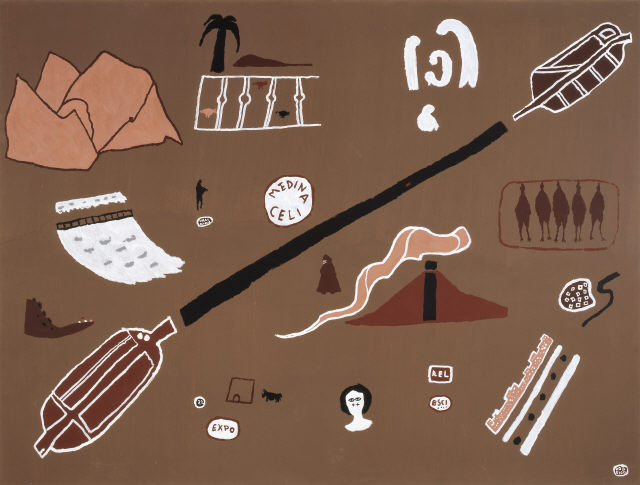
- Platex
- Tempera
- Inv. 83P525
Joaquim Rodrigo
Madrid – Vallauris
Madrid – Vallauris (1969) is a large format, tempera on platex work created by Joaquim Rodrigo in the late 1960s. Signs, concrete forms reduced to their most schematic design, human figures, all more or less levelled by a miniature scale, appear scattered and isolated in the uniform background with its velvety ground tone symbolising an element that the artist has always loved and appreciated – earth. Tonal harmony prevails: chalky whites, ochres, light and dark browns, blacks are the preferred colours in this, as in numerous other works created by Joaquim Rodrigo during this period: aware of himself as a man rooted in his territory, as the agronomist and landscape gardener which he never ceased to be.
The painting thus reflects the importance of the geographical areas covered or visited, memorised, in this case, from the travel notes made by the painter in 1968 in Spain and southern France, always mediated by a poetry of the earth – "Poetics of the will", according to Gaston Bachelard – which, from the 1960s onwards, indeed became a kind of hallmark of the work of Joaquim Rodrigo. The journey from Madrid, the Spanish capital, to Vallauris, a town in Côte d'Azur in the South of France, was certainly not fortuitous: it was in Vallauris that the master of modern art Pablo Picasso had established himself between 1948 and 1955, producing significant works of pottery and sculpture. Joaquim Rodrigo was certainly not unaware of the importance of Picasso’s stay in this French seaside resort for the renaissance of ceramics, an equally telluric art also very much akin to his own concept of painting, using clay as a raw material or pigment.
In Madrid – Vallauris, the idea of transportation or crossing, reinforced by the black bar that divides the space in a diagonal ascending from left to right, is also suggested by other ideogramatic elements and inscriptions. An example is the reference to Medinaceli, the village of the “Bulls of Fire”, a seasonal resort encountered halfway, doubly marked by the inscription in a small white circle coupled with the inscription in red earth placed just above and near to the black diagonal. This is completed by the presence of a tiny animal, in the opposite plane, a reference to the Spanish location. In the vicinity, other signs herald the appearance of observed shapes (grids, artichokes, palm trees…), human figures (head, front or profile views) or orographic details, completing a cartographic lexicon without perspective and with no defined centre. Joaquim Rodrigo would reformulate this incessantly until his death in 1997, as part of his diligent search to return to an art of basic principles, an "elementary or first grade" art, as he called it.
Exhibited for the first time in 1969 at the Banco Português do Atlântico’s Exposição de Artes Plásticas (Exhibition of Plastic Arts), Madrid – Vallauris is a fine example of the concepts of art that Joaquim Rodrigo would theorise, a few years later, in O Complementarismo em Pintura (Complementarism in Painting), 1982.
Ana Filipa Candeias
May 2013
| Type | Value | Unit | Section |
| Height | 149 | cm | |
| Width | 200 | cm |
| Type | date |
| Type | signature |
| Type | Acquisition |
